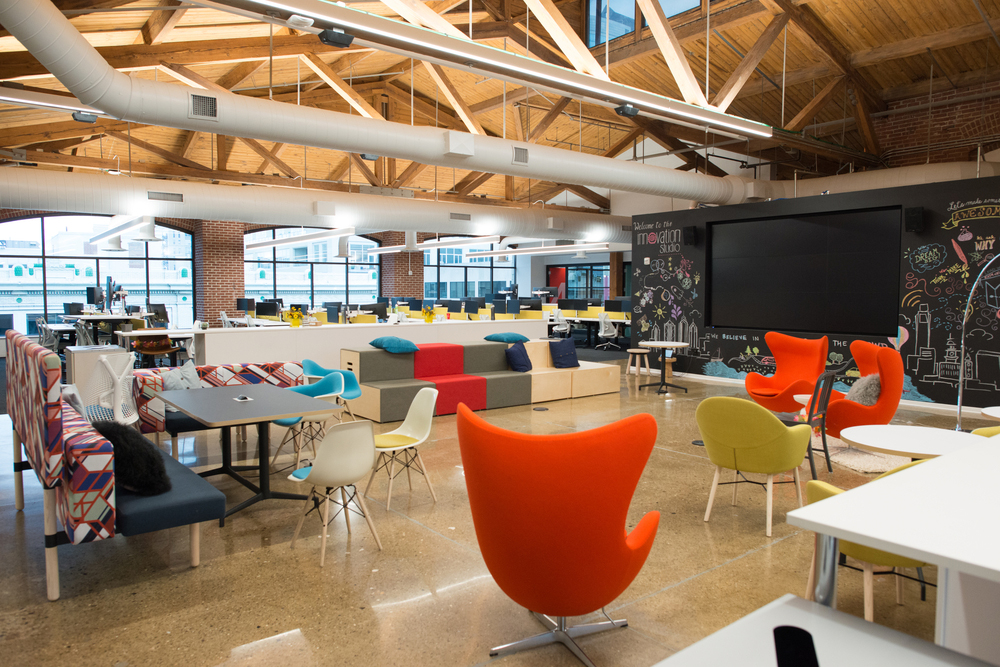Activity-based work environments are beginning to gain real traction inside the modern-day workplace, along with more agile workforces. But what exactly is activity-based work?
Activity-based work is reliant on flexible work space designs that allow employees to choose which workstations they will work at for specific tasks or activities. In such environments, employees don’t have designated workstations and are empowered to choose which ones best fit their needs for certain tasks on any given day. For more insight, keep reading.
Statistics for Activity-Based Work to Consider
- 88% of highly engaged employees have the option to choose where in the office they work based on the specific task(s) they need to do.
- 98% of highly satisfied employees work at a company where they have the freedom to move around the office during the day.
- A British utilities company, National Grid, reduced its operational costs by $11.43–$14.29 million by implementing activity-based working. It also saw an 8% increase in overall productivity.
- Nearly 70% of participants in one study claimed that an activity-based working environment increased their productivity, and two-thirds claimed their work was more stimulating.
(Source: iOffice)
Pros of Activity-Based Work
Research suggests that activity-based work environments improve workplace sedentary time and physical activity, eating behaviors, support for being physically active in the workplace, and overall workplace satisfaction. Essentially, activity-based work environments can increase employees’ overall mental, physical, and social well-being, saving employers money on healthcare-related costs and significantly improving employees’ productivity.
Activity-based work environments can also help organizations save on expenses associated with employees’ having private workstations. When spaces are shared, organizations will spend less on things like individual desks and desktop computers.
Cons of Activity-Based Work
If activity-based work environments aren’t designed and managed appropriately, employees could become less productive as a result. For instance, employees will need equal access to quiet spaces to complete work on their own, as well as access to more collaborative meeting spaces. Otherwise, activity-based work environments could become too noisy or isolating to encourage productive and engaged employees.
In addition, employees should be able to book certain workstations on a first-come, first-served basis so they don’t fill up too quickly by the same individuals every day.
Now that you’ve gained some insight into activity-based work, we’ll cover how your organization can implement activity-based work.
How to Implement Activity-Based Work Environments
Here are a few things you should do if you’re interested in implementing an activity-based work environment at your own organization.
Do your research, and outsource help. Before you begin to draw up plans for an activity-based work environment, it’s important to do your research first. Parse through case studies and research that detail the successes and failures of organizations that have already implemented activity-based work environments. Consider what worked for them and what didn’t, as well as how activity-based work environments affected their bottom lines and employee engagement rates.
| Has your HR team implemented changes that have reduced ergonomics-related injuries? Take this survey to share how you have addressed changes to office and workstation design or improvements you have considered making. |
Also, consider hiring or consulting professionals who specialize in work space designs, as they will be aware of which activity-based work environments may or may not work for your organization based on industry insights, best practices, etc.
Gain buy-in across your organization. After completing some research, it’s important to solicit feedback from your organization’s executives, management, and employees. Gain general insight into what their concerns are regarding implementing an activity-based work environment. Without everyone’s approval and buy-in across your organization, you will not be able to successfully implement this type of environment.
Executives won’t support work environments that they don’t understand or that won’t improve your organization’s bottom line. Management won’t support work environments they don’t know how to, or don’t want to, manage. And employees won’t work in environments that aren’t engaging or helpful to their everyday work responsibilities.
Invest in change management. If you’re implementing new work spaces and revamping everyday environments, be sure to invest in managing such changes across your organization.
If you don’t invest in managing the changes that come with implementing a new work environment, expect to receive a lot of resistance and pushback from key stakeholders and employees across your organization.
Consider your company’s culture and needs. Before implementing an activity-based work environment, consider whether your organization will truly benefit from such a work environment, as well as its existing company culture. Some industries and organizations will not benefit from shared and flexible work spaces and may actually be better off providing private workstations.
In addition, activity-based work environments should be customized for each organization’s existing culture for maximum efficiency and effectiveness. While some organizational cultures will necessitate more meeting and collaborative spaces, others might need access to workstations with highly customized software and technology, for example.
To successfully establish an activity-based work environment, keep the best practices above in mind.

